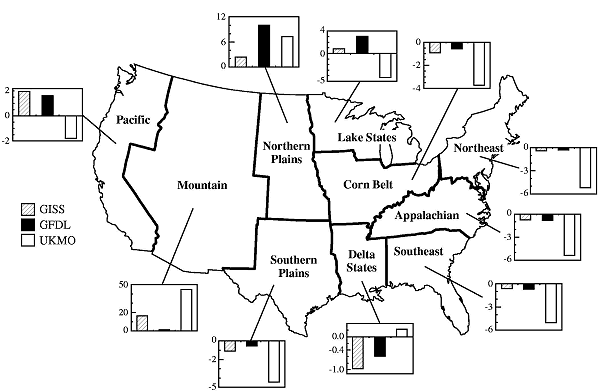8.3.4.5. Yield and Production Changes by North American Subregion
Previous studies that have simulated the impact of climate change on the North
American agriculture sector have taken a variety of approaches. Tables 13-11
and 13-12 in the SAR (IPCC 1996, WG II) outline the range and variability of
yield impacts that have been suggested across a number of studies looking at
climate change impacts for the United States and Canada. For these studies (IPCC
1996, WG II, Section 13.6.8), when biophysical and economic impacts were combined,
market adjustments were found to lessen the impacts of negative yield changes.
More recent projections of increases in global mean surface temperatures in
the future are lower than past estimates. These lower estimates are derived
from new, transient GCM scenarios that take into account the interactions between
the atmosphere and oceans and the cooling effects of sulfate and other aerosols
in the troposphere (Darwin, 1997). Most of the impact studies currently available
for review have not utilized the projections from these more recent climate
model simulations as a background; as a result, they may overestimate the magnitude
of expected temperature impacts.
The outcome of the net economic impact summarized in the SAR (IPCC 1996, WG
II, Section 13.6.8) was sensitive to assumptions about population, income, trade
barriers, and institutions and ranged from negative to positive. For Canada,
the vulnerability of the agricultural sector derives from the importance of
agriculture to subregional (e.g., the prairies) and rural economies, the location
of agriculture in a marginal climate with regard to temperature and precipitation,
and limitations to northward shifting of cropping by poor soil quality (Cohen
et al., 1992).
Economic welfare may improve for more northerly farm production regions-with
potential benefits indicated for the lake states, the northern Plains, the mountain
region, and the Pacific region.
Evaluation of the direct and indirect effects of climate on yield at the farm,
regional, or higher level of aggregation requires integrated models that consider
system interactions. Changes in crop production, crop water demand, and regional
water resources will arise as a consequence of climate change, although the
impacts of these changes on agriculture will be modified by trends in world
food production and commodity exports. These interactions can be modeled to
estimate the economic consequences of climate change for regions of the United
States. Adams et al. (1995a,b) used three GCM scenarios to evaluate the economic
consequences to crop production and regional welfare if climate changes of similar
magnitude were to occur. Figure 8-8 illustrates the
subregional variability in economic welfare suggested by climate change, including
a CO2 fertilization effect (and accounting for changes in export demand). Based
on these analyses, eastern, southeastern, and corn belt regions yielded estimates
of negative impacts, while positive effects were projected for northern plains
and western regions.
 |
| Figure 8-8: Effects of climate change on regional economic welfare
(percentage change in total welfare from base, assuming 555 ppm CO2 and
changes in export demand) (adapted from Adams, 1995b). See page 287 for
details of the climate scenarios used. |
(continues on next page...)
|